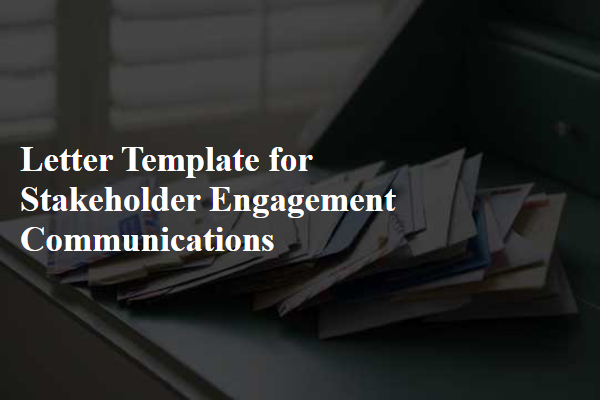Engaging with stakeholders is essential for fostering strong relationships and driving successful outcomes in any organization. Whether you're reaching out to partners, investors, or community members, crafting a well-structured letter can effectively convey your intentions and encourage collaboration. In this article, we'll explore key elements of a stakeholder engagement letter that resonates and inspires action. Ready to elevate your communication skills? Let's dive in!

Clarity and Brevity
Effective stakeholder engagement communications require clarity and brevity to ensure all parties understand key messages. Clear objectives, such as project timelines or expected outcomes, should be outlined in concise bullet points for quick reference. Use specific metrics, like engagement levels or feedback percentages, to demonstrate the importance of stakeholder input. Utilize straightforward language free of jargon to maintain accessibility. Localize content by incorporating community-specific references, such as upcoming town hall meetings in Springfield, to foster connection and relevance. Regularly scheduled updates, like monthly newsletters or quarterly reports, can help sustain interest and involvement among stakeholders.
Tailored Messaging
Tailored messaging is essential for effective stakeholder engagement, ensuring communication resonates with specific audience needs and interests. For instance, local community members may prioritize environmental impacts, while investors might focus on financial returns. Engaging stakeholders requires identifying key concerns, such as economic benefits (increased job opportunities), social implications (community development initiatives), and sustainability efforts (carbon footprint reduction goals). By customizing messages to highlight these relevant factors, organizations can foster robust relationships, enhance collaboration, and build trust with diverse stakeholders. Effective channels for outreach may include targeted newsletters, personalized emails, and interactive community forums to facilitate open dialogue.
Engaging Subject Line
Effective stakeholder engagement communications require a compelling subject line to capture attention. A well-crafted subject line should highlight the purpose of the message while reflecting the interests of the stakeholders involved. For instance, "Join Us for the Upcoming Sustainability Initiative Meeting" emphasizes the collaborative nature of the upcoming event regarding environmental practices. Including specific dates, such as "March 15: Important Update on Project Milestones," highlights urgency and encourages immediate action. Tailoring the subject line to the audience, including key phrases relevant to their interests, can significantly enhance engagement rates, making recipients feel valued and informed.
Call to Action
Stakeholder engagement is crucial for successful projects, particularly in initiatives like community development or corporate sustainability efforts. Engaging stakeholders effectively requires clear communication and organized outreach strategies. Timely notifications often involve methods such as emails, newsletters, or dedicated meetings to discuss objectives. Key factors include identifying influential stakeholders, such as local government officials, community leaders, and industry experts, and understanding their interests or concerns. Implementing a Call to Action, such as inviting stakeholders to participate in workshops or surveys, fosters collaboration, enhances input and ensures alignment on project goals. Ultimately, establishing a feedback loop strengthens relationships and builds trust among all parties involved.
Professional Tone
Stakeholder engagement plays a critical role in the success of any organization. Effective communication strategies foster transparency and build trust among stakeholders. Regular updates on project milestones, such as quarterly progress reports and annual stakeholder meetings, ensure all parties are informed. This includes sharing key performance indicators (KPIs) that reflect organizational goals and outcomes. Utilizing platforms like webinars or informational newsletters can enhance engagement, enabling stakeholders to voice concerns and provide input. Utilizing professional language and clearly defined messages helps establish authority and encourages collaborative relationships. Overall, a proactive communication approach strengthens stakeholder relations and drives collective growth.













Comments